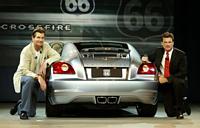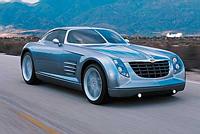With Crossfire, Chrysler and Mercedes cross-breed
DETROIT, Jan 3 Reuters rteports that a sports coupe set to appear on American roads next year will be the first true child of the marriage between Chrysler and Mercedes after years of trial and turmoil.
The 2004 Chrysler Crossfire, to be unveiled on Thursday at the Los Angeles Auto Show, is a German-American crossbreed. It borrows about 39 percent of its parts from Mercedes, including its engine. It will be built in Germany, in the same Karmann plant as the Mercedes CLK sports coupe. And its existence comes thanks to the two former Mercedes executives who now run Chrysler.
But DaimlerChrysler AG will need more of that kind of cooperation to reverse Chrysler's massive losses and live up to the promises made when it was formed by the merger of Chrysler Corp. and Daimler-Benz AG in 1998.
``It's the first really strong evidence of the benefits of the merger,'' said Larry Achram, Chrysler's vice president for advance vehicle engineering. ``We have a lot of possibilities.''
The $36 billion merger between Chrysler and Daimler-Benz in 1998 was fueled by the promise of grand synergies between the two companies.
But since then, DaimlerChrysler's fortunes have soured as Chrysler's losses grew into the billions of dollars and many of the savings from the marriage between the companies simply did not appear.
Synergies fell victim to a cultural divide as wide as the Atlantic. Daimler executives were once wary of even admitting that Jeep and Mercedes sport utility vehicles were sharing an assembly line in Austria, lest the Mercedes brand image be tarnished by association with Chrysler.
And while the two have swapped manufacturing tips and executives, only after the arrival of Dieter Zetsche as president and Wolfgang Bernhard as chief operating officer in 2000 did component sharing between Mercedes and Chrysler take on a sense of urgency.
Now there are several plans to use Mercedes parts in future Chrysler vehicles, including axles, transmissions and electrical components. Parts sharing is a key part of Zetsche's $4 billion plan to return Chrysler to profitability next year.
AMERICAN NAME, GERMAN PARTS
The Crossfire is the first Chrysler vehicle approved under Zetsche and Bernhard to go into production. It retains many of the cues of last year's concept car, such as a decorative ``spine'' that runs the length of the vehicle, with a few modifications such as a larger rear window and a concealed rear spoiler.
Power comes from a 215-horsepower Mercedes V6, the first use of a Mercedes engine under a Chrysler badge in the United States, routed through either a six-speed manual or five-speed automatic transmission.
With Mercedes' help, the Crossfire will go into production in Germany some 14 months after the vehicle's design was settled, about 10 months less than most vehicles require. And after killing the uniquely American Prowler, the Chrysler brand now has an image car it can shop to buyers around the world.
In size and function the rear-wheel-drive Crossfire targets the $33,000 Audi TT coupe. But the TT is more than a competitor -- it's also an inspiration for the Crossfire, whose brushed aluminum control panel and reddish-brown leather interior borrow many Audi styling cues.
``The interior of many of our products has been influenced by benchmarking Audi,'' Achram said. ``Between them and Mercedes-Benz, there is a benchmark quality we don't see in our domestic competition.''
Chrysler executives declined to reveal the Crossfire's price or production estimates. Audi sells about 12,000 TTs a year in the United States.




